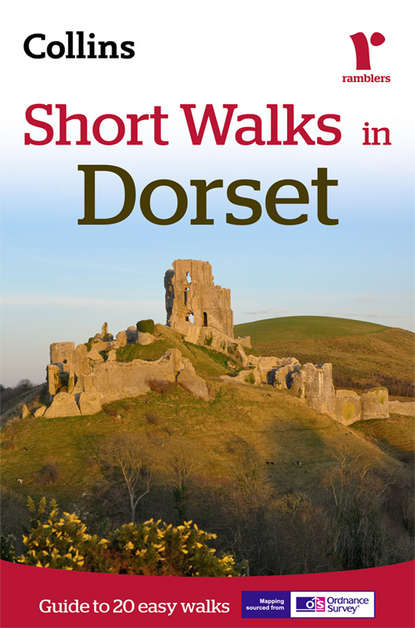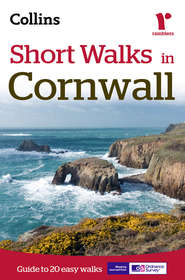По всем вопросам обращайтесь на: info@litportal.ru
(©) 2003-2024.
✖
Short Walks in Dorset
Автор
Год написания книги
2018
Настройки чтения
Размер шрифта
Высота строк
Поля
Southeast Dorset lies on non-resistant Eocene clays, sands and gravels, the thin soils supporting a heathland habitat. The River Frome estuary runs through this weak rock and its many tributaries have carved out a wide estuary. At the mouth of the estuary sand spits have been deposited turning the estuary into Poole Harbour. The harbour and the chalk and limestone hills of the Purbecks to the south lie above Europe’s largest onshore oil field.
Most of the Dorset coast (together with part of the East Devon coast) was listed as an UNESCO World Heritage Site in 2001 because of its impressive geological formations and textbook examples of features of coastal erosion. The coast represents much of the Mesozoic era (251-66 million years ago) with a sequence of Triassic, Jurassic and Cretaceous rock exposures and it is commonly known as ‘The Jurassic Coast’. It has yielded a large number of animal and plant fossils including flying reptiles, marine reptiles and dinosaur footprints. The notable landforms include the sea stacks near Handfast Point, the cove at Lulworth and the natural arch of Durdle Door. The limestone island of Portland is connected to the mainland by the 18 mile pebble tombolo of Chesil Beach. The Fleet Lagoon, which Chesil Beach encloses, is one of the most important saline lagoons in Europe.
In the west of Dorset the chalk and clay begins to give way to marl and granite, more characteristic of the geology of Devon.
Wildlife in Dorset
The variety found in the Dorset landscape is reflected in its wildlife. Added to which, the southerly location and relatively warm climate make it possible for many species to survive compared with places further north in Britain. All six native species of reptile can be found here. The fragments of heathland left in Dorset are home to many rare plants and animals. In summer you may see an emperor dragonfly, or a silver-studded blue butterfly. The smooth snake, one of Britain’s rarest reptiles, has its home on the open heathland together with the sand lizard, while a marsh gentian may be seen amidst thicker vegetation. On the limestone cliffs, in summer, look out for the adonis blue butterfly. Gulls, including kittiwakes, abound along the coast and the coastline provides many breeding grounds for seabirds, as well as habitats for overwintering birds. Portland Bill is a major bird migration point, spring or autumn being the best time to witness this spectacle. In summer the flocks of mute swans can be seen at Abbotsbury. Poole Harbour is a feeding ground for many birds, including a large colony of black-headed gulls. Information on wildlife in Dorset can be obtained from the Dorset Wildlife Trust as well as the location of nature reserves within the county.
Hardy’s Wessex
Thomas Hardy was convinced that ‘it is better for a writer to know a little bit of the world remarkably well than to know a great part of the world remarkably little’. His little bit of the world was Dorset and the surrounding counties, which became his fictionalised Wessex. County boundaries were disregarded, while towns and villages were renamed, often transparently, giving Hardy his own stage upon which his stories were set. Hardy’s Wessex became vividly detailed, making its exploration fascinating.
The landscape of Hardy’s Wessex is far from uniform. Its variety is striking, from the Vale of the Little Dairies to the wilds of Egdon Heath and the inspiring Wessex Heights. Its core is Hardy’s native parish of Stinsford (the ‘Mellstock’ of the novels). Hardy was born here in a cottage at Higher Bockhampton in 1840. This was then a wild, lonely place where ‘snakes and efts swarmed in the summer days, and nightly bats would fly about our bedrooms’. The most prominent features of Hardy’s boyhood environment were the Heath and the River Frome, which separates Bockhampton from the county town of Dorchester. Hardy gave the individual heaths, which extend to Poole Harbour, the collective name of Egdon Heath, where the outlook was ‘lone and bare’. The wild beauty of this excited Hardy’s imagination, especially in The Return of the Native, where Clym Yeobright ‘was permeated with its scenes, with its substance, and with its odours’. In The Mayor of Casterbridge, Hardy described the heath as ‘that ancient country whose surface never had been stirred to a finger’s depth, save by the scratching of rabbits, since brushed by the feet of the earliest tribes’. Only small pockets of this heathland have survived the agricultural improvements and the dense conifer afforestation of the 20th century,
The River Frome flows eastwards to Poole Harbour. Its green, fertile valley was where the waters ‘were as clear as the pure River of Life shown to the Evangelist, rapid as the shadow of a cloud, with pebbly shallows that prattled to the sky all day long’. In autumn the river filled up and ‘the smallest gullies were all full; there was no taking short cuts anywhere, and foot passengers were compelled to follow the permanent ways’. Angel Clare courted Tess here, ‘in the valley her spirits up wonderfully’ upon first sight. This is still a lush, dairy-farming landscape, although the milkmaids have been replaced by machines. Here was a rich seam from which Hardy could link the environment with human emotions, as in Tess of the d’Urbervilles: ‘Amid the oozing fatness and warm ferments of the Froom Vale, at a season when the rush of juices could almost be heard below the hiss of fertilization, it was impossible that the most fanciful love should not grow passionate. The ready bosoms existing there were impregnated by their surroundings’.
The Vale of Blackmoor, or Blackmore, was the home of Tess. Its gateway is Sturminster Newton, past which flows the River Stour and it is best seen from the surrounding heights. The river and its tributaries give the vale its character, enhanced by the villages which cluster on islands of higher ground above land liable to flooding. Hardy wrote in The Woodlanders that the Vale ‘cannot be regarded as inferior to any inland scenery of the sort in the west of England, or perhaps anywhere in the Kingdom’. The heavy clay soil is the kind where Hardy felt ‘superstitions linger longest’. The trees relate to humans, as in The Woodlanders, when Marty South remarked that the young pines she was planting seemed to ‘sigh because they are very sorry to begin life in earnest - just as we be’.
The downland ridges of Dorset were Hardy’s Wessex Heights, ‘where men have never cared to haunt nor women have walked with me, and ghosts then keep their distance; and I know some liberty’. The north Dorset escarpment overlooking the Vale of Blackmore constantly recurs in the novels. Here is the scene of Tess’s poverty-stricken winter at Flintcombe-Ash, ‘a starve-acre place’ where ‘Tess slaved in the morning frosts and in the afternoon rains’. Not far from here is the Giant of Cerne Abbas, the ‘Cernel Giant’ who ate babies in ancient times, according to Mrs Cantle in The Dynasts. This is also sheep country and Hardy wrote of the sheepfair at ‘Greenhilll’ (Woodbury Hill) outside ‘Kingsbere’ (Bere Regis), the annual gathering on the top of a hill attended by ‘multitude after multitude’ of ‘horned and hornless’ sheep. Nearby is Tolpuddle, the home of the trade union Martyrs. Their trial was held in Dorchester, Hardy’s ‘Casterbridge’ and the town most closely associated with the novelist.
Hardy’s Wessex also has fine coastal scenery. Weymouth was only 10 miles (16km) from Hardy’s home and he was fond of ‘the boats, the sands, the esplanade’. Hardy wrote Desperate Remedies, his first published novel, in Weymouth, but The Trumpet Major and The Dynasts are the fruits of a longer association with the coast. Hardy’s grandparents remembered when this coastline was under threat of invasion by Napoleon, and folk-memories and legends from the time enliven Hardy’s works. The Hand of Ethelberta is the novel of Purbeck. This ‘isle’ is a microcosm of the Dorset landscape, with chalk, clay, limestone, sand and shale, rugged and gentle scenery. It is reached through the gap guarded by Corfe Castle which, like the cliffs and headlands of Purbeck, was visited frequently by Hardy. The newly-married Thomas and Emma Hardy walked the cliffs east of Swanage, where the detached stumps of chalk stand witness to the power of the waves. Further west, towards Weymouth, the spectacular cove at Lulworth is where Sergeant Troy was thought to have drowned in Far from the Madding Crowd.
Walking tips & guidance
Safety
As with all other outdoor activities, walking is safe provided a few simple commonsense rules are followed:
• Make sure you are fit enough to complete the walk;
• Always try to let others know where you intend going, especially if you are walking alone;
• Be clothed adequately for the weather and always wear suitable footwear;
• Always allow plenty of time for the walk, especially if it is longer or harder than you have done before;
• Whatever the distance you plan to walk, always allow plenty of daylight hours unless you are absolutely certain of the route;
• If mist or bad weather come on unexpectedly, do not panic but instead try to remember the last certain feature which you have passed (road, farm, wood, etc.). Then work out your route from that point on the map but be sure of your route before continuing;
• Do not dislodge stones on the high edges: there may be climbers or other walkers on the lower crags and slopes;
• Unfortunately, accidents can happen even on the easiest of walks. If this should be the case and you need the help of others, make sure that the injured person is safe in a place where no further injury is likely to occur. For example, the injured person should not be left on a steep hillside or in danger from falling rocks. If you have a mobile phone and there is a signal, call for assistance. If, however, you are unable to contact help by mobile and you cannot leave anyone with the injured person, and even if they are conscious, try to leave a written note explaining their injuries and whatever you have done in the way of first aid treatment. Make sure you know exactly where you left them and then go to find assistance. Make your way to a telephone, dial 999 and ask for the police or mountain rescue. Unless the accident has happened within easy access of a road, it is the responsibility of the police to arrange evacuation. Always give accurate directions on how to find the casualty and, if possible, give an indication of the injuries involved;
• When walking in open country, learn to keep an eye on the immediate foreground while you admire the scenery or plan the route ahead. This may sound difficult but will enhance your walking experience;
• It’s best to walk at a steady pace, always on the flat of the feet as this is less tiring. Try not to walk directly up or downhill. A zigzag route is a more comfortable way of negotiating a slope. Running directly downhill is a major cause of erosion on popular hillsides;
• When walking along a country road, walk on the right, facing the traffic. The exception to this rule is, when approaching a blind bend, the walker should cross over to the left and so have a clear view and also be seen in both directions;
Вы ознакомились с фрагментом книги.
Приобретайте полный текст книги у нашего партнера:
Приобретайте полный текст книги у нашего партнера:










